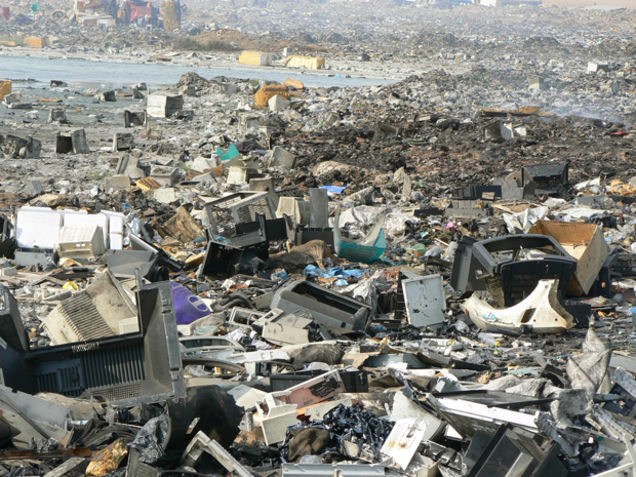Op/Ed: Why your stuff turns to junk so fast (and cooks the planet)
Note: This article was originally posted on the Worldwatch Institute blog. Worldwatch is an independent research organization based in Washington, D.C. that works on energy, resource, and environmental issues.
Much of the energy of the environmental movement and of policymaking is focused on reducing greenhouse gas emissions through low- or zero-carbon development. This is a necessary and, in many ways, proper focus. But it is too narrow an approach to deal successfully with the broader challenge of endless growth in consumption, which is a major—yet less discussed—contributor to the climate problem.
Climate policies are unfolding at a time of continued economic crisis, marked by widespread deflation and a mismatch between productive capacities and consumer demand. The conventional solution to this crisis is to stimulate demand—encouraging people to “buy more stuff.” The result is thus to reinforce existing energy- and materials-intensive patterns of production and consumption, rather than to modify them.
There is growing recognition that human well-being needs to be decoupled from resource consumption.
There is growing recognition that human well-being needs to be decoupled from resource consumption: in other words, individual prosperity must continue to grow while simultaneously reducing the impact on the planet. The question is how to achieve this. Increasing the efficiency of energy and materials use is one critical strategy, but it does confront limits: greater efficiency makes resource consumption cheaper, which can encourage greater use of resources—the so-called rebound effect.
Even though resource productivity has improved, the overall demand for resources keeps rising.
Where it has occurred, decoupling has been of a relative nature. Even though resource productivity has improved, the overall demand for resources keeps rising. A new report from the United Nations Environment Programme (UNEP) finds that global extraction of materials has tripled since 1970 (see Figure), far outstripping the pace of population growth, which has doubled. Average materials use per person grew from 6.4 tons to 10 tons between 1970 and 2010. Not once in the last 40 years has materials extraction declined, even during times of recession.
UNEP’s findings point to a worrisome reality: globalization and outsourcing strategies have shifted production from more material-efficient economies (such as in Japan or parts of Europe) to less efficient economies (such as in China, India, and Southeast Asia), leading to an overall decline in global material productivity since the turn of the century.
Planned Obsolescence and the Consumerist Economy
Another approach for tackling rising resource consumption is to lengthen the useful life of goods, and thus to reduce their turnover rate. The widespread acceptance of “planned obsolescence”—or artificially limiting the useful life of a product by making it unfashionable or no longer functional—has been a major driver of unsustainable economic structures for the last century or so. Some trace the concept to traveling salesman King Camp Gillette, who in 1895 came up with the idea of disposable razor blades—a product for which consumers would have to keep coming back over and over again.
The widespread acceptance of “planned obsolescence” has been a major driver of unsustainable economic structures.
The 1920s saw among the first concerted efforts at planned obsolescence, when a group of leading lightbulb manufacturers (the Phoebus Cartel) decided to sell only bulbs that had a lifespan of 1,000 hours or less. The typical range at the time was 1,500 to 2,000 hours, and some bulbs lasted as long as 100,000 hours. Since then, many companies, no matter how simple or sophisticated their products are, have hewed to the same underlying philosophy in pursuit of ever-growing sales.
With the help of advertising, design changes, and other strategies, companies promote frequent changes in fashion and in consumer perception (“must-have” models or styles), push inferior products (flimsy materials and components), and introduce technical incompatibilities (such as in computer components and software). The upshot is a significant reduction in the useful life of products, and the limited ability to repair and upgrade them. Thus, far more products are manufactured, sold, and discarded than necessary, translating into ever-rising throughput of energy and materials; waste flows and pollution; ecosystem destruction and biodiversity loss; and climate change.
In consumerist societies, consumption unsurprisingly plays a central role in people’s sense of status and supposed happiness.
In consumerist societies, consumption unsurprisingly plays a central role in people’s sense of status and supposed happiness. But more systemic issues are driving rising consumer demand as well. Over the decades, numerous authors have remarked upon the apparent fundamental need of the consumerist economy for planned obsolescence, particularly during key transitional moments in recent history. (See Box.)
How obsolescence became the new “normal”
I would have the Government assign a lease of life to shoes and homes and machines, to all products of manufacture, mining and agriculture, when they are first created, and they would be sold and used within the term of their existence definitely known by the consumer. After the allotted time had expired, these things would be legally ‘dead’ and would be controlled by the duly appointed governmental agency and destroyed if there is widespread unemployment. New products would constantly be pouring forth from the factories and marketplaces, to take the place of the obsolete, and the wheels of industry would be kept going and employment regularized and assured for the masses. London further proposed that “when a person continues to possess and use old clothing, automobiles and buildings, after they have passed their obsolescence date, as determined at the time they were created, he should be taxed for such continued use of what is legally ‘dead.’” Similarly, a 1936 essay cautioned against “Outmoded Durability: If Merchandise Does Not Wear Out Faster, Factories Will Be Idle, People Unemployed.”
Our enormously productive economy demands that we make consumption our way of life, that we convert the buying and use of goods into rituals, that we seek our spiritual satisfactions, our ego satisfactions, in consumption. The measure of social status, of social acceptance, of prestige, is now to be found in our consumptive patterns. The very meaning and significance of our lives today expressed in consumptive terms…. These commodities and services must be offered to the consumer with a special urgency.… We need things consumed, burned up, worn out, replaced and discarded at an ever increasing pace.
|
Changing the Rules of Consumption
If the environmental and climate challenge is to be resolved, however, society cannot forever turn to wasteful production and consumption patterns as a way to stave off economic crisis. A different approach is needed to resolve today’s existential question of sustainability. Economies are human constructs, and we can and must change the rules by which economies function, although this is admittedly far easier said than done.
In a July 2016 essay in The New Yorker, “The L.E.D. Quandary: Why There’s No Such Thing As ‘Built To Last’” J.B. MacKinnon points to several possible measures: Governments can legislate minimum standards for durability, repairability, and upgradeability. Ecological tax reform—lowering taxes on labor and raising them on energy and raw materials—can provide much-needed signals in favor of these goals. Sales-tax rates that are differentiated according to product lifetimes could achieve similar results. Consumer guarantees and warranties, together with labeling programs or rating schemes, play an important role in communicating product qualities to consumers.
Another measure, introduced principally in European countries since the 1990s for a limited range of products, is so-called extended producer responsibility (EPR), making manufacturers of products responsible for their entire life-cycle, including take-back, recycling and final disposal. Well-designed EPR policies can nudge design in the direction of greater durability and repairability.
Well-designed EPR policies can nudge design in the direction of greater durability and repairability.
The purchase cost of more durable, repairable, and upgradable products is higher than that of short-lived ones. To make ecologically responsible consumer decisions more palatable, green financing programs may be needed. In parallel, manufacturers of durable products might be given advantageous lending terms and tax rates (or tax rebates), or in selected cases targeted subsidies, in order to recalibrate the level playing field and to allow them to compete with producers of short-lived items.
Tradeoffs
There are some tradeoffs. Green standards and mandates (for instance, existing bans on the sale of inefficient incandescent light bulbs or future bans on gasoline-powered cars) may trigger a large-scale turnover (forced obsolescence) of existing products. A careful phase-in may be needed to avoid unintended repercussions.
Durability also might inhibit green innovation. Japan’s “Top Runner” program, for instance, has been setting efficiency standards for a range of products since 1989. Advisory committees, drawn from academia, industry, consumers, and local governments, meet regularly to determine the most efficient models across a range of consumer goods categories, which then become the new baseline for all manufacturers. This drives a process of continuous innovation. Different products and markets may require a careful choice between the potentially conflicting goals of green innovation and durability. A more modular approach to product design could limit the inherent tradeoff.
What Are the Implications?
Unit for unit, short-lived products are cheaper than durable ones. This can be a considerable advantage for manufacturers or for people who have to stretch their budgets. But this seeming advantage may be an illusion. For consumers, the need to buy multiple replacement items in place of a single, longer-lasting one could well mean a greater cost over time. To determine this, however, life-cycle cost studies would be needed for a broad range of products.
Moving toward a less consumptive, more durable economy has repercussions.
Moving toward a less consumptive, more durable economy has repercussions. Employment in mining and other primary industries, although already declining, would suffer because there is less need to keep digging up materials for new products (especially if a durability strategy is paired with ambitious recycling and reuse). In the manufacturing sector, the picture is more mixed. On one hand, the quantity of mass-produced goods would be lower and jobs would be lost. On the other hand, manufacturing fewer, yet longer-lived, products would require greater care and presumably more people. Assembly line workers who perform the same task repetitively would, to some extent, give way to craftspeople with higher skills and creativity.
Happiness, Actually
Yet the needed changes go far beyond technical and design alterations. Companies, including the financial sector, would need to develop dramatically different business plans, and governments would need to fundamentally revamp the workings of the economy. Environmentalists have long talked about the need to deemphasize GDP growth. GDP would lose its holy grail status and be replaced with indicators attempting to measure human well-being, such as those proposed by the Commission on the Measurement of Economic Performance and Social Progress, the World Happiness Report, and others.
Critiques of planned obsolescence are far from new. But building a more durable economy has become a more pressing task in the age of impending climate chaos. It will require a cultural sea-change in consumerist societies. Other factors might assist such a move, such as a declining pace of innovation and rising costs of material inputs. Detailed assessments are needed to understand the full impacts of such a shift and to find ways to safeguard human well-being while restructuring the economy. This also requires detailed analyses of employment impacts, as well as support measures for a “just transition” for affected workers and communities.
In other words, industrial societies have figured out a functioning system built on the idea of throwing things away as quickly as possible. The task now is not only to envision a different system, but to build one that works, too.
AUTHOR’S UPDATE: Above, I argued that the conventional response to economic crisis—“ exhorting people to buy more stuff”—is inimical to efforts to bring the economy in line with planetary limits. Calling for low-carbon development has become the mainstream approach to our resource and environmental problems. There is nothing wrong with this, per se. But the world needs to move beyond efforts to shift toward renewable energy and greater energy efficiency, as important as these goals are.
I suggested that a more fundamental problem needs to be tackled: planned obsolescence—the now-widespread approach to designing and manufacturing products that ensures that things fall apart quickly and need to be replaced. We need to rediscover concepts like durability and repairability.
Readers might feel sympathetic, but I can imagine the rejoinder: sure, nice vision, but how are you going to make it happen?
Well, the governing coalition in Sweden just made a move that allows me to claim that I’m not just living in a dreamland. It is proposing that parliament agree:
- to cut the tax rate on repairs to shoes, clothes, and bicycles from 25 to 12 percent.
- to allow half of the labor cost of repairing large household appliances to be claimed back on incomes taxes
- to establish a tax on new computers and appliances to internalize environmental costs of materials that often cannot be recycled.
The Guardian quotes Per Bolund, a Green Party member and minister for financial markets and consumer affairs, as saying that the measures are intended to stimulate the repair industry in Sweden, helping to create much-needed employment.
Detractors will call this move as returning to the economy of the past—when it actually paid to fix stuff rather than throw it away, no matter the environmental cost. I call it a move to create the economy of the future.
Michael Renner is a senior researcher at the Worldwatch Institute. His work has principally focused on two topics—the connections between environment and employment (green jobs), and linkages between the environment and peace and conflict.
This article was originally posted on the Worldwatch Institute blog. Worldwatch is an independent research organization based in Washington, D.C. that works on energy, resource, and environmental issues.


























